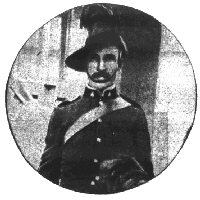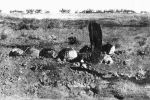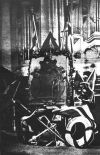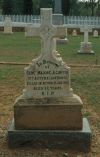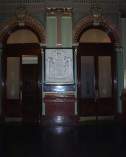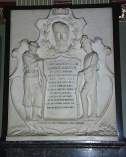Biography – Sgt-Maj George Allman Griffin
First Australian Horse Regimental No 367, Sergeant Major
George Allman Griffin, was born on 12 August 1866 at Braidwood, the son of James Harrop Griffin, gold commissioner and magistrate, and his wife Mary, nee Allman. He was educated at the public school in Braidwood, and moved to Sydney at the age of seventeen. Griffin followed the family military tradition and at an early age enlisted in a military unit. His maternal grandfather, Francis Allman, was a captain in the 48th Regiment of Foot, serving in the Peninsular War, before coming to New South Wales and being appointed commandant of Port Macquarie convict establishment.
Griffin served with the Royal Artillery (Naval) Reserve for thirteen years and then the First Australian Horse. At the time of his enlistment he was working as an accountant at the Mount Kimo Gold Mines in Gundagai.1 He was credited with taking a prominent part in the formation of the Gundagai squadron of the First Australian Horse, of which his brother Walter Trementere Griffin, a solicitor, was the commanding officer. Prior to his departure for South Africa George was entertained by the members of his former unit the Naval Brigade and presented with a testimonial.
The contingent left Newcastle on the Langton Grange under the command of Lieutenant Willoughby Dowling, arriving in Cape Town on 14 November 1899. On arrival they were attached to the Royal Scots Greys serving under General French's command.
At dawn on 16 January, Lieutenant W V Dowling of the Mudgee Squadron of the Australian Horse led a party of NSW Lancers and Australian Horsemen to patrol the area towards Norval’s Pont, north-east of Colesberg. It is believed that a Dutch farmer warned the Boers, of the whereabouts of the Australian patrol and they successfully ambushed the patrol at Rensburg. Griffin was killed by a bullet wound to the head and Lance Corporal Kilpatrick fatally wounded. Fourteen members of the patrol, including Dowling, were taken prisoner, with the remainder managing to escape capture.2 The following day a patrol was sent to the scene of the ambush –
They saw a man making efforts to lift his leg to attract attention. It was Kilpatrick. He was a terrible sight; all the lower part of his face was shot away. He could nor speak. He had been there all night and had written “cold” on the ground with his fingers….His wounds had been bandaged roughly with the field dressing, evidently by the Boers, but strange to say they had not taken his bandolier , which contained a few cartridges. Nothing was in his pockets…The rocks were all spattered with blood and pieces of field dressing....Then the searchers came on the body of Sergeant Griffin, First Australian Horse.3
The Braidwood Despatch of 21 February 1900 stated that he had apparently died without pain. His face was perfectly peaceful. The medical officer attending the scene reported that he buried Griffin where he had fallen and returned with Kilpatrick in an ambulance.4 Kilpatrick died later that day and was buried on a hill at Slingersfontein.
Griffin was the first man serving in a New South Wales unit to die in the South African War.
The news of his death caused deep sorrow in the town of Gundagai and the residents quickly established a fund to erect a monument to the memory of George Griffin and others that might fall in the conflict.
The Naval Artillery Volunteers and the First Australian Horse joined to erect a monument in the Sydney Town Hall in memory of Sergeant Major Griffin. At an impressive ceremony, presided over by the Mayor of Sydney, a plaster replica was unveiled on the eve of the departure of the Imperial Bushmen's Contingent for South Africa. The commanding officer Lieutenant-Colonel Kenneth Mackay, a personal friend of Griffin, had the honour of unveiling the replica, as the marble monument had not then been completed. The memorial's inscription reads –
|
In Memory of |
George Griffins's remains were moved to the Colesberg Garden of Remembrance some years later. His memorial can be seen in the Town Hall, Sydney and on the Boer War Memorial in Gundagai.
Acknowledgement – Peter and Fred Mayberry
1 Nominal Roll, First Australian Horse, National Archives of Australia Series B5205 Folder 5a
2 The place of the ambush is reported variously as Rensberg, Norval's Pont and Slingersfontein.
3 The Finding of Kilpatrick, A B [Banjo] Paterson, Sydney Mail, 24 February 1900.
4 The original place of burial according to the National Monuments Council of South Africa was Kleinfontein not Rensberg.
5 The Griffin Memorial Tablet, Sydney Mail 5 May 1900.
